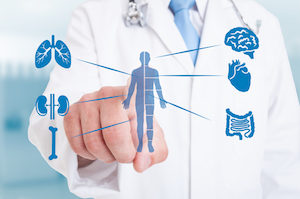According to the American Autoimmune Related Diseases Association, Inc., autoimmune diseases affect as many as 50 million people in the United States. These diseases often leave patients with chronic pain, or with other life-altering symptoms and disabilities that reduce their quality of life. Many of the patients we treat at Innovations Stem Cell Center have pain and other side effects caused by an autoimmune disease.
What Are Autoimmune Diseases?
Autoimmune diseases are painful and chronic health conditions that happen when the body’s own immune system attacks any of the healthy cells, organs, and tissues in the body. These attacks leave these cells, organs, and tissues damaged, disabled, and dysfunctional. According to the AARDA, there are over 100 known autoimmune illnesses. Autoimmune diseases cause illnesses like type 1 diabetes, rheumatoid arthritis, scleroderma, Crohn’s disease, muscular dystrophy, and multiple sclerosis.
What Causes Autoimmune Diseases?
Autoimmune diseases are caused by genetic and environmental factors. The AARDA estimates that almost 30 percent of autoimmune diseases are caused by genetics passed on from one generation to the next. The AARDA estimates the other 70 percent are caused by triggers like bacterial and viral infections, environmental and chemical irritants, and certain behavioral factors, like poor diet and substance abuse.
Who Develops Autoimmune Diseases?
Although these diseases can strike anyone, women are more prone to develop autoimmune disorders. The AARDA says that about 75 percent of autoimmune diseases occur in women and that autoimmune diseases are among the leading causes of death for women between 20 and 60. Patients with a parent or grandparent with an autoimmune disease are at a greater risk of developing an autoimmune disease.
What Are the Signs of Autoimmune Diseases?
Since autoimmune disorders can affect so many different parts of the body, they present themselves in many different ways. The most common symptoms of autoimmune diseases are extreme fatigue, pain in the joints and muscles, and unexplained weight loss. This makes diagnosis difficult and for many people means living a life with pain and disability while doctors search for answers.
How Can Stem Cell Therapy Treat Patients with Autoimmune Diseases?
Conventional medical treatments typically only treat the symptoms of autoimmune diseases, like pain, swelling, or fever. These treatments, like pain relievers or anti-inflammatory medications, only bring temporary relief- which can be frustrating for many individuals.
Innovations use stem cells taken from the patient’s own adipose fat tissue through liposuction to treat patients. Stem cell therapy helps to heal tissue damaged by the immune system’s attack, giving patients long periods of relief from their symptoms. Long-term relief from pain and other symptoms gives patients back their quality of life. Although in some cases, patients may need repeated treatments, relief from symptoms is immediately seen, and results are long-lasting. For more information read our blogs What are Stem Cells? and Understanding Adipose-Derived Stem Cells
Stem cells are also immune modulators. This means that in addition to being able to heal diseased tissue, they also have the unique ability to help regulate the immune system back to normal function. This helps to decrease the autoimmune disease activity, giving patients even greater relief from their pain.
Do you have questions about how Innovations Stem Cell can bring you relief from your autoimmune disease? Call (214) 643-8665.

